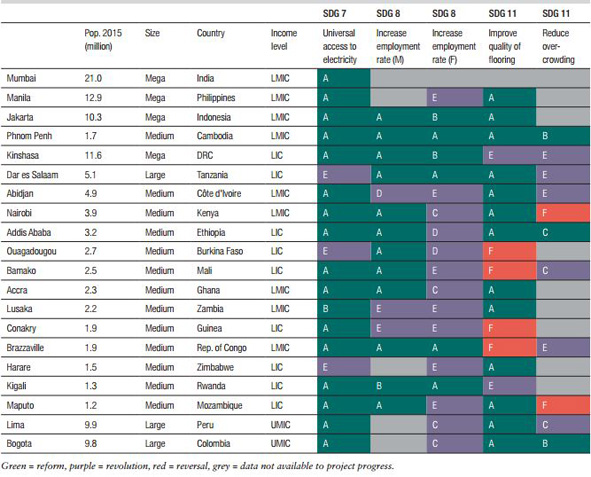web_slummumbai_istock_000017951487_large.jpg

A Mumbai slum. The provision of adequate housing was one area where the ODI's analysis suggests many of the world's cities are likely to fall short.
Analysing the current progress of 20 global cities towards achieving a selection of the SDG targets, the Overseas Development Institute concluded that the majority will need a “profound acceleration” of efforts if they are to meet half of the targets included by 2030.
By the middle of the century, 70% of the global population will live in cities. As the world becomes increasingly urbanised, the ODI’s report highlighted that it “it is difficult to see how the SDGs could be achieved” without a well-managed urban transition and local governments meeting their responsibilities to deliver basic services.
table_5b_odi4.jpg

The progress of 20 cities towards five SDG targets. A = will meet the target. B = more than half way to the target. C = More than a third of the way to the target. D = More than a quarter of the way to the target. E = Little to no progress towards target. F = Progress in the wrong direction. Source: Overseas Development Institute
In the group of 20 cities across Asia, Africa and Latin America, for example, only eight were on track to achieve universal access to drinking water when measured by the level of piped water in houses.
That falls to just five in regards to achieving universal access to adequate sanitation, when based on access to flush toilets.
The ODI said that there are therefore 10 and 12 cities that need to “revolutionise” their approach to the two targets for drinking water and sanitation respectively. If these cities carry on at the same rate, most will find themselves halfway or less to the target by 2030, according to the report.
Of all the targets included, cities performed by far the worst on ending child malnutrition. Just two of the cities studied were set to meet targets on stunting of children under five – Lima in Peru and Conakry in Guinea.
In two cities, Abidjan in Côte d’Ivoire and Harare in Zimbabwe, stunting in under-fives was instead increasing, and the ODI noted a complete “reversal” of current trends would be needed.
A further three cities are currently just over a third of the way to this target, while 10 are either just over a quarter or have made little to no progress at all.
odi_table_5a3.jpg

The progress of 20 cities towards five SDG targets. A = will meet the target. B = more than half way to the target. C = More than a third of the way to the target. D = More than a quarter of the way to the target. E = Little to no progress towards target. F = Progress in the wrong direction. Source: Overseas Development Institute
On the target most obviously linked to cities – access to adequate housing for all – the ODI found that data was too often limited or of poor quality.
It called on statistical offices and city information systems to improve the available data, for example through additions to existing household surveys, and for governments and city administrations to invest more in statistical capacity.
A “huge challenge” for many local city governments is that they also lack the resources and capacity to deliver, pointed out Paula Lucci, research fellow at the ODI and one of the authors of the report.
“If the world is serious about meeting these targets then cities need to be a central part of it. Only by increasing the resources and the capacity of local governments will this ambitious agenda have a chance of succeeding,” she stated.
A recent report by the OECD also found that the world’s cities are at risk of becoming “inequality traps”, that become more unequal as they grow without careful planning, Already, cities in all but one of 10 countries studied have higher levels of income inequality than their respective national averages, the report found.
Today, more than half of the world’s population live in cities. As that figure continues to rise, so do the inherent challenges city growth entails.
Speaking yesterday to mark World Cities Day, United Nations secretary general Ban Ki-Moon also stressed the increasing importance of urban investment and carefully planned city growth.
“To transform our world, we must also transform its cities,” he said. “They are central to climate action, global prosperity, peace and human rights.
“Crime, pollution and poverty are taking their toll on hundreds of millions of city-dwellers. At the same time, urban areas are hubs of energy, innovation and economic dynamism. By investing in cities, we can advance progress across societies.”













